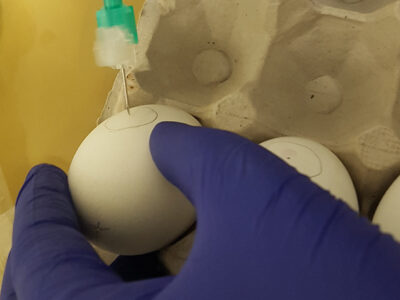



Researchers aim to develop vaccine for infectious poultry disease
WCVM researchers aims to help solve a huge problem for the poultry industryInfectious bursal disease virus (IBDV) in broiler chickens (birds raised for meat) is a costly issue not only in Canada but worldwide. While Saskatchewan represents less than four per cent of Canada’s total poultry industry, the province loses an estimated 3.9 million kilograms of meat per year in Saskatchewan because of this virus.

“This is a global thing,” says Dr. Susantha Gomis, a professor in the WCVM’s Department of Veterinary Pathology. “Everywhere there’s a chicken, it’s there.”
IBDV is a primary immunosuppressive disease in broiler chickens. The virus targets and destroys nearly all of the B cells — antibody-producing cells — in the chicken’s immune system. Once the B cells are destroyed, “one part of the immune system is completely gone,” says Gomis. “Young broilers could be infected as early as the day of hatch when they are placed in the barn.”
Gomis compares IBDV in chickens to HIV (human immunodeficiency virus) that causes AIDS in people. Once the birds are infected with IBDV, they’re more easily susceptible to other illnesses due to their severely weakened immune systems.
IBDV is incredibly prevalent in Saskatchewan and is found in just over half of the chicken barns in the province. Once IBDV gets into a chicken barn, it’s extremely hard to eradicate – especially in older barns that don’t have concrete flooring. In these facilities, IBDV can’t be completely cleaned away, even with disinfectants. Darkling beetles that live underground can also carry IBDV and transmit the virus to the chickens.
“If it’s in the barn, it’s hard to get rid of and then the birds are more prone to bacterial and viral diseases. And then there’s a huge economic impact of that, so they’ll have more dead birds from secondary infections,” says Shelly Popowich, a research officer in Gomis’s lab. “It definitely affects not just on farm, but the whole food supply chain as well.”
Saskatchewan’s main variant of IBDV — SK09 — is 95% similar to NC171, a variant from North Carolina, USA. But even that 5% difference is enough to make existing IBDV vaccines ineffective.
“Right now, there are IBD vaccines that are commercialized in Canada, but they’re not specific for what’s in Canada,” says Popowich.

All vaccines for IBDV are manufactured in the United States, and while they’re effective in combating the U.S. variants of the virus, they’re of little use against the Canadian viruses.
SK09 makes up nearly 60% of all IBDV infections in Saskatchewan, while four variants of the virus (SK10, SK11, SK12, and SK13) are responsible for the other 40% of cases in the province. Many of the Saskatchewan variants are comparable to variants out of the U.S. For example, SK11 is most similar to a Delaware variant and SK13 is most similar to a Brazilian variant of IBDV.
Gomis’s lab is working to develop a Canadian vaccine that will specifically target the Canadian variants of IBDV. The team is working on attenuating, or reducing virulence, the live IBD potency to make an immune complex vaccine.
Working with chicken embryos and cell lines, the WCVM team members are growing and harvesting the virus so they can eventually produce an attenuated version — a virus incapable of causing disease.
“Right now, we’re on the 20th passage and we’ve got a long way to go yet before we get to that 100 mark,” says Popowich.
She adds that the development of the vaccine targeting Canadian IBDV variants will be significant for chicken producers as well as for hatcheries and processing plants.
“Seeing the changes to the embryos because of the virus and knowing that it’s growing there and knowing that it’s eventually going to be attenuated is kind of exciting to see,” says Popowich. “You can actually physically see the changes from the virus in the lab and know that it’s actually going to make an impact once it becomes a vaccine [that’s available] for producers.”
The IBDV vaccine research project is supported by Saskatchewan’s Agriculture Development Fund (ADF). The Natural Sciences and Engineering Research Council of Canada (NSERC), Chicken Farmers of Saskatchewan and Canadian Poultry Research Council support development of an immune-complex and vectored IBDV vaccines.
Headline image: WCVM research officer Shelly Popowich (left) and Thushari Gunawardana, a former graduate student and postdoctoral fellow (right) work in Dr. Susantha Gomis's poultry research lab. Submitted photo.









